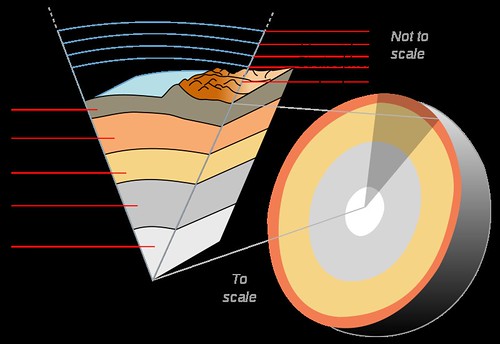Earth has an outer silicate (sand, Portland cement, and thousands of minerals are examples of silicates) solid crust, a highly viscous )between solid and liquid) mantle, a liquid outer core that is much less viscous than the mantle, and a solid inner core.
Scientific understanding of Earth's internal structure, says Wikipedia, is based on observations of topography and bathymetry, observations of rock in outcrop, samples brought to the surface from greater depths by volcanic activity, analysis of the seismic waves that pass through the Earth, measurements of the gravity field of the Earth, and experiments with crystalline solids at pressures and temperatures characteristic of the Earth's deep interior.
Inner core: 4000 miles deep, super-hot but solid, iron & nickel.
outer core: liquid, super hot
mantle: silicon, aluminum, magnesium, iron, etc; "This mixture continually rises, cools, sinks warms up, and rises again, releasing 80% of the heat generated from the eartth's interior." - WG
crust: broken, rocky shell; plates of the crust float upon the upper mantle.
- continental drift theory
- plate tectonics, perhaps caused by interior heat.
- magma
- subduction: heavier sea plate slides beneath the lighter continental plate.
- accretion: adding to the material of the earth's crust.
- spreading: sea plates pulling apart, creating a rift (crack).
- folds: layers of rock that have been bent under pressure.
- faulting: cracks in the crust; associated with earthquakes.
- ring of fire: earthquake-prone zone that surrounds the Pacific.
skip to main |
skip to sidebar
For students and parents who love education and exploration of the social sciences . . .
Search This Blog
Followers
Blog Archive
-
▼
2011
(242)
-
▼
August
(28)
- Huck and Jim, 2011, geography class narrative on r...
- 12 pt narrative project: A river ride down the MIs...
- Eid Mubarak! A celebration after the Muslim month ...
- Source of much of America's electricity: cheap coa...
- Geography: Aquifers and derricks
- Understanding the term "regions": maps of the I-20...
- Comparing population trends using lines of latitude
- For your projects in world geo: a printable blank ...
- Demonstrating knowledge of the global grid: Google...
- Shreveport Times: Take a truly regional approach t...
- Author John Corey Whaley of Springhill chats about...
- K'naan: a young singer from Somalia
- Patterns in the lines of latitude: great cities
- Additional materials: Mississippi watershed map
- What to do with the class blog? Copy and highlight
- Assignment 4: copy and color a world map that show...
- My Very Early Morning Jam Sandwich Usually Nauseat...
- Earth's crust and the other delicious parts
- Ciao!
- Where did all your body water go, dear Ramses?
- Guidelines for papers & projects, 2011 - 2012
- How to identify locations on spaceship earth: cook...
- Assignment 3 / Mississippi River tributaries: Ohio...
- Asssignment 2: Shreveport, the Red River and Cross...
- Solar panel breakthrough engineered by 13 year-old...
- Notebook and fee in geography / Trudeau, 2011-2012
- Assignment 1: map of Louisiana's rivers, lakes & c...
- Waterways and Louisiana Project: from the Red Rive...
-
▼
August
(28)

